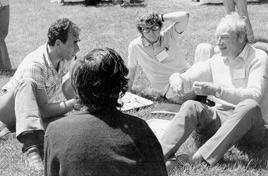1977: Chromatin, Vol. XLII
Organizer: James Watson
At the conclusion of the 1973 Symposium on Chromosome Structure and Function, Hewson Swift had emphasized, while enthusing on the progress since the 1941 Symposium, that a very great deal of work remained to understand eukaryotic chromosome structure and function; after all, the small lac operon had required uncountable hours of study. How was it, then, that only four years had elapsed before Watson felt another Symposium on the same topic was justified? As Watson put it in his foreword, amazing progress had been made during that brief period, in part because of the development of recombinant DNA techniques.
The first part of the Symposium dealt with the large-scale structure of chromosomes and chromatin. In 1974, Roger Kornberg had proposed, based his biochemical studies of the formation of histone complexes together with a synthesis of many other data, that DNA and histones are associated in units—nucleosomes—containing eight histone molecules and 200 base pairs of DNA. Now, no fewer than 30 papers were devoted to the nucleosome. The opening paper of the Symposium was from Aaron Klug and John Finch describing their X-ray crystallographic tour-de-force-the crystallization and high resolution analysis of rat-liver nucleosomes.
The second part of the meeting dealt with functionally active chromatin, that is chromatin that is being transcribed. Here the bombshell, as Watson put it, was the description of splicing of Adenovirus messenger RNAs, in reports from the MIT and Cold Spring Harbor groups. Chambon in his summary described this as the highlight of the meeting, and in his published remarks drew on results that came after the meeting, to show that
| 
RNA splicing was not a peculiarity of DNA viruses, but occurred in eukaryotes as well. Chambon was able to point out how this discovery resolved various anomalies—for example, the nature of heterogeneous nuclear RNA became clear.
The third part of the meeting discussed the structure of genes as revealed by the new techniques of recombinant DNA. While these techniques had been used with viruses, it was only in 1976 that the first eukaryotic genes had been cloned. Papers in these sessions described the cloning and analysis of globin, immunoglobulin, silk chorion and fibroin genes, as well as repeated sequences from Drosophila and sea urchin. These cloned genes or fragments were already being used as tools in developmental and evolutionary studies.
While the 1963 Symposium had marked the closing of an era in the molecular genetics—the broad sweep of the molecular basis of life, from DNA to protein had seemed laid out—the 1977 Symposium looked to the future, giving tantalizing glimpses of the treasures that were to be discovered in the following decades using recombinant DNA techniques.
— Jan A. Witkowski |